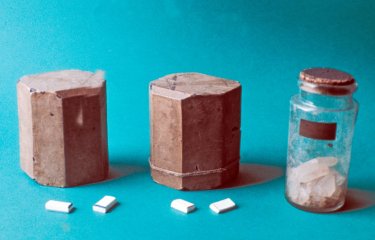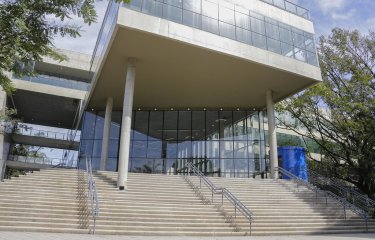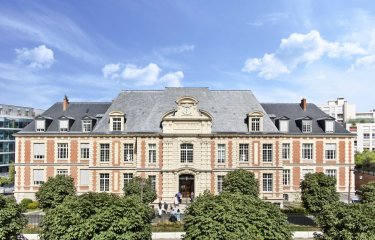On December 11, 2018, the Institut Pasteur awarded the 20 students of the 2018 Pasteur iGEM team. They came back with a gold medal from the competition that was held in Boston from October 24 to 28. Each year, the Massachusetts Institute of Technology (USA) organizes the international competition iGEM (Genetically Modified International Machine), which promotes research in synthetic biology. For the Pasteurian team, this was the fourth participation in the competition.
The iGEM community is underpinned by a philosophy of collaboration, respect, fair play and mutual scientific inspiration. This year, more than 300 teams and 6,000 participants gathered for the culminating event of the iGEM competition, known as the Giant Jamboree, to share and celebrate their achievements in the area of synthetic biology. Attending this year were the students from the 2018 Pasteur iGEM team and their coaches, who came to present their project NeuronArch, a universal biological interface for prostheses that enables the residual nerves of amputated limbs to connect to prostheses.
According to current statistics, every 30 seconds a limb is lost to diabetes, and more than 3 million people affected by a physical disability will require a prosthesis by 2050. These figures spurred the students in the 2018 Pasteur iGEM team to try to find a solution that would improve mobility and safety for amputees.


"People with prostheses need to contract adjacent muscles to perform even the simplest of movements," explains Deshmukh Gopaul, a scientist in the Design for Biology Center and leader of the Pasteur iGEM project. "The aim of our project was to improve the quality of life and independence of amputees by devising a smart prosthesis which could be "taught" everyday movements by patients."
Improving human-machine communication
In amputees, human-machine communication is unable to function correctly because of damage to the nerves and the neuromuscular interface. Electrical signals can no longer be transmitted because nerve cells are unable to activate target muscles or relay sensory information from the limbs to the brain. To restore communication, the students designed an interface surrounded by a biofilm, in other words a community of microorganisms encased within a matrix. This idea is a radical departure from current research on biofilms – such as the work being carried out by Jean-Marc Ghigo, from the Institut Pasteur's Department of Microbiology, on new approaches to combat biofilms formed by several bacteria, including Staphylococcus aureus. These biofilms form on medical instruments, contributing to the development of hard-to-treat infections. "Biofilms are formidable adversaries," continues Deshmukh Gopaul. "So we wanted to see if we could use their properties of resilience and their ability to survive normally in the body to our advantage."
Taking this idea as a starting point, the Pasteur iGEM team looked for a way of helping amputees' motor neurons to regenerate and connect to the interface, located in a metal part of the prosthesis attached to the stump. The multidisciplinary team joined forces to come up with a mathematical model capable of simulating neuron growth towards the biofilm in response to the neurotrophin NGF (nerve growth factor), a molecule responsible for the development of new neurons and the growth and maintenance of mature neurons. They then created a physical model, using a microfluidics chip, to illustrate the neuron/conducting membrane/biofilm interface. The biofilm was engineered to enable it to produce NGF.

Tackling infection
The project takes things a step further. The artificial composition of prostheses and the fact that they are foreign bodies mean that the formation of pathogenic biofilms is a constant threat. Infections occur in 1.5 to 2.6% of orthopedic surgeries performed in the United States, out of a total number of around 7 million every year. These infections sometimes require prostheses to be replaced, representing a considerable economic and medical burden.
"The students' strategy was to focus their efforts on tackling Staphylococcus aureus, since it is the main cause of infection," explains Deshmukh. And this time, they had no choice: they needed to find an anti-biofilm strategy.
"To overcome the problem, we chose to disrupt the sensing activities of the bacterial community." Also known as "quorum sensing", this is a series of regulatory mechanisms that control the coordinated expression of some bacterial genes within a single bacterial population. The students came up with the ingenious idea of "disguising" their bacteria (Escherichia coli) as Staphylococcus aureus, thereby turning them into "secret agents". This synthetic bacterial population in the form of a protective biofilm is therefore able to gather information sent by the neighboring staphylococci and emit the wrong signals, triggering destruction of the Staphylococcus aureus biofilm that is starting to form.
Future prospects
The team earned a gold medal and a nomination in the Best Product Design category for their in vitro validation, conceptualization of an interface device and a charging station, and 3D modeling of each component.
Encouraged by the positive reaction to their NeuronArch project, students from the Pasteur iGEM team presented their work to the European Parliament in Brussels on September 28 during a session on synthetic biology. "We are now hoping to further our collaboration with the Brain & Spine Institute, with whom we have already had fruitful discussions." After this first exploratory year, the students are keen to consolidate their project and develop their partnerships. "The company iCERAM, which produces ceramic prosthetics, has shown real interest in our project, as has BIOASTER in our new antimicrobial approaches. We would also like to work with companies specializing in artificial intelligence to enhance our interface," concludes Deshmukh Gopaul.
The students have been congratulated for their efforts and achievements at the prize-giving ceremony on December 11 at the Institut Pasteur (Paris).
For more information, please visit





